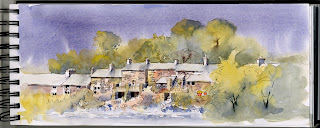





Jenny’s studio set up
The most common criticism of painting in pastel is the problem of dust. This can be a concern if you have breathing problems or are sensitive to dust . I am asthmatic myself. However there are a number of methods of reducing the dust considerably.
On the right is a page from my new book, Painting with Pastel, which reproduces my studio set up. (copyright Paul Bricknell and Search Press)
My three point dust reduction plan is as follows:-
1. Always work with the painting vertical on an easel with a right angled channel, (cardboard or plastic) under the drawing board. This allows the pastel dust to drift down into the channel and you do not have to blow away the excess pastel as you would if the painting was at a shallower angle. If you don’t like standing you can use a desk easel, but keep the painting vertical. You can make an angled channel with a length of mountboard. At the end of a painting session I rarely have more than a quarter of a teaspoon of dust in the channel.
2. Keep a dry flannel in your hands while you are working. This serves two purposes; it keeps your hands relatively clean and you can clean any grubby sticks as you work so that you can identify the colours easier.
3. Work on fine sandpaper; the abrasive quality of the surface grips the pastel and produces less dust than working on paper. Sandpaper also encourages you to work ‘thin’, i.e. use fewer layers of pastel. I find the colours are more vibrant on sandpaper and there is no need to build up layers to get depth of colour.
You will notice in the photograph there is also an old towel on the floor, this also absorbs any dust and prevents dropped pastels from breaking. The towel on the table helps to keep the pastel sticks clean.
The tools in the holder hanging from the easel include colour shapers for blending, brushes for removing mistakes and palettes knives for creating the spatter effect (more on that in another post) etc.
I have been experimenting with Pan Pastels, as you will see from some of my other posts, and have found that they produce much less dust than stick pastels. The method of working in Pan Pastel is quite different from stick pastel and a number new techniques need to be developed. If you want to see some of these, I have an article in the March 2012 issue of Leisure Painter Magazine. (available now)

Sketching in watercolour or pen and wash is a very quick way to capture colour and tone out of doors and it has the added benefit of loosening up your painting style. After all it is only a sketch and not intended for exhibition and because your time is limited it is not so easy to overwork it. You can learn a lot from sketching in watercolour.
Even if you are not particularly mobile, if it is possible for you to get out and enjoy nature, do try and do some sketching out of doors. I’m convinced you will find it improves your work.

Little Langdale
In this painting of Little Langdale the esoteric atmosphere I was trying to create was of an isolated farmhouse, surrounded by the mountains, abandoned and slowly decaying, there are no animals, the roof is beginning to sag and the wilderness is returning to the fields. All is not lost though, the roof is intact. Perhaps someone will make it a home once again.
The other meaning of the word atmosphere in this painting is created by the use of colour, tone, and detail. These are the three essential ingredients to help you create a sense of recession in your painting, and I make no apology for referring to them time and time again. Keep the distant features cooler in colour, lighter in tone and with less detail than the foreground and middle distance features and you will be well on your way to inviting your viewer into the picture,
You can read more about this aspect of painting and many other tips in my book, Painting with Pastels, published by Search Press. There is also a DVD of the same name to accompany the book and a special offer on the two together.

Misty marsh in Pan Pastel
The sparkle of light on water and a gauze of mist lends enchantment to almost any scene.
In this painting the misty effect was achieved with Pan Pastels on a sheet of white Clairefontaine Pastel Mat paper.
The method of applying the Pan Pastel colour with sponges naturally lends itself to soft edges. The water is mainly the paper left untouched but the highlights on the clouds were created with a small Sofft
tm tool which looks like a plastic palette knife with a sponge sleeve and is very effective for smaller areas.
The challenge of working with Pan Pastels, which does not lend itself readily to creating sharp edges, has made me re-evaluate the amount of fine detail I include in a painting and has ‘loosened up’ my recent work. Working with different methods of applying colour is a stimulus that can get you out of a rut.
Go on try something new.
I will be running a pastel painting course in Cheddar next autumn if you would like to learn more about my methods of working.